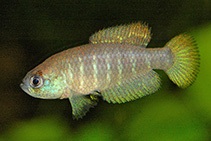| Family: |
Rivulidae (Rivulines), subfamily: Cynolebiinae |
| Max. size: |
3.42 cm SL (male/unsexed); 3.48 cm SL (female) |
| Environment: |
benthopelagic; freshwater |
| Distribution: |
South America: known only from the type locality, a temporary pool in the rio Vacacaí drainage, rio Jacuí tributary, laguna dos Patos drainage in Brazil. |
| Diagnosis: |
Vertebrae: 28-30. Distinguished from its congeners except from those of the Austrolebias alexandri species-group by the dark gray pectoral fins combined with the bright blue iridescence in males. Differs from other species of the Austrolebias alexandri species-group by fewer scales around caudal peduncle (12 vs. 16 or more) and the fewer dorsal-fin rays in males (17-21 vs. 20 or more ). Can be differentiated from all other species of the genus by the absence of contact organs on the inner surface of the pectoral fin in males and the color pattern of females - ground color light brownish, sides of body with a variable number of relatively large dark black spots distributed mostly on posterior portion of body (Ref. 76851).
Description: dorsal fin rays 17-21 in males and 15-21 in females; anal fin rays 19-23 in males and 17-19 in females. Longitudinal series of scales 25-26; transverse series of scales 11-13 (Ref. 76851). |
| Biology: |
Inhabits temporary pool, almost completely covered with emergent vegetation (Ref. 76851). |
| IUCN Red List Status: |
Vulnerable (VU); Date assessed: 07 November 2018 (D2) Ref. (130435)
|
| Threat to humans: |
harmless |
Source and more info: www.fishbase.org. For personal, classroom, and other internal use only. Not for publication.
